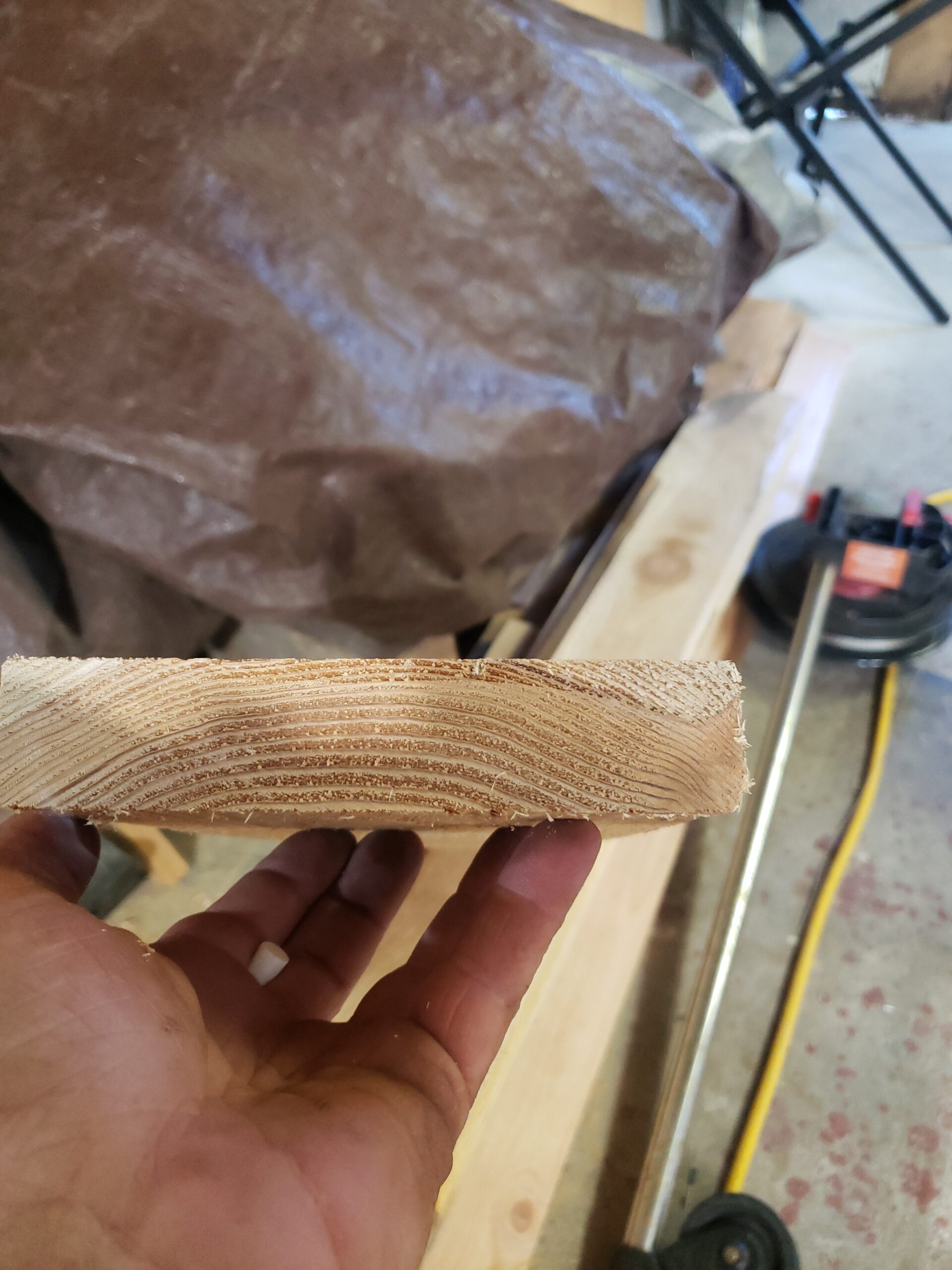I was recently asked about the proper direction and surface orientation of boards when laying out exterior decks and stairs here in the Cowichan Valley. Whether you’re building in Shawnigan Lake, Cobble Hill, Mill Bay, or Duncan, it’s a question that sparks considerable debate among local builders, but the answer lies in understanding how wood behaves in our unique Pacific Northwest climate.
Understanding Wood Grain Patterns
When you look at the end grain of a board, you’ll notice the growth rings form distinct patterns:
Heart side up
The growth rings curve in the shape of a “U” or cup
Bark side up
The growth rings form an arch or rainbow shape

Figure 1 Bark Side Up

Figure 2 Heart side up
Both orientations have their advocates, but Mother Nature has already determined the best choice for exterior applications.
Why Bark Side Up is the Superior Choice
For exterior decks and stairs in the Cowichan Valley, bark side up is the preferred orientation, and here’s the science behind it:
Moisture Resistance in Our Climate
The bark side of wood is typically more resilient at resisting moisture absorption. This is especially important in our region, where we experience heavy rainfall from October through March, followed by drier summer months. The board won’t move as dramatically when it gets wet, providing better dimensional stability during our dramatic seasonal weather changes.
Water Management
When a bark-side-up board does absorb moisture and move, it arches upward. This natural cupping action is particularly beneficial during our wet Valley winters, as it helps shed water from the surface, reducing standing water that can lead to:
Ice formation during those occasional February cold snaps
Water retention during our extended rainy season
Accelerated rot from moisture trapped on deck surfaces
Premature deterioration, especially problematic given the investment in quality lumber in our area
Safety Considerations
Heart side up creates the opposite effect – the board cups upward along the edges, creating a depression that holds water. On stairs, this becomes a significant safety concern as the leading edge rises, increasing the height of the stair nose and creating an uneven, potentially hazardous stepping surface.
Special Techniques for Wide Boards
On large stair treads (12 inches wide or more), experienced carpenters often employ an additional technique called “kerfing.” They run a saw cut on the underside (heart side) of the board to prevent excessive arching. This shallow cut:
Prevents the board from becoming semicircular
Reduces the tendency for checking (cracks at the board ends)
Maintains a flatter, safer walking surface
Code Requirements and Professional Practice in the Cowichan Valley
It’s worth noting that neither the National Building Code of Canada nor the BC Building Code specifically dictates which way these boards should be oriented. Local building departments in Duncan, North Cowichan, and the Cowichan Valley Regional District don’t have specific requirements either. However, approximately 80% of experienced carpenters throughout the Valley – from Mill Bay to Duncan – follow the bark-side-up rule to ensure both safety and longevity of their construction projects, especially given our challenging coastal climate.
When Rules Have Exceptions
As with most construction practices, there are situations where builders might deviate from this guideline:
Aesthetic Considerations
If the bark side of a particular board isn’t visually appealing, some carpenters may choose to install it heart side up. In these cases, they’ll typically use additional fasteners to minimize the potential for cupping.
Species Variations
Different wood species react differently to moisture, which can sometimes alter these general guidelines. The specific characteristics of the lumber being used should always be considered.
Interior Applications: A Different Story
Everything discussed above applies specifically to exterior applications. Interior hardwood floors and stairs operate under completely different principles because:
Indoor temperature and humidity remain relatively constant
Boards don't experience rapid expansion and contraction cycles
The controlled environment minimizes dimensional changes
For interior work, aesthetic considerations often take precedence over moisture management concerns.
The Bottom Line for Cowichan Valley Builders
While there’s no absolute answer that applies to every situation, the bark-side-up approach represents time-tested wisdom that’s particularly well-suited to our coastal climate. Whether you’re building a deck overlooking Shawnigan Lake or stairs leading down to your Mill Bay waterfront, this approach will serve you well. When in doubt, don’t hesitate to ask your local carpenter about their board orientation choice and listen to their reasoning.
As an addendum to this discussion, it ultimately comes down to the individual carpenter’s decision. Some prefer one approach over another based on their experience with specific conditions in our area – whether dealing with the heavy rains near Cobble Hill or the more sheltered conditions in parts of Duncan. Otherwise, about 80% of deck and stair builders throughout the Cowichan Valley follow the bark-side-up rule for good reason.
Remember: where building codes leave gaps, experience governs a carpenter’s decisions. The goal is always to create safe, durable, and attractive outdoor living spaces that will withstand our beautiful but challenging Vancouver Island climate for years to come.
